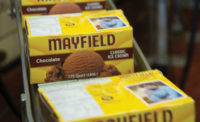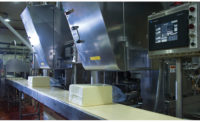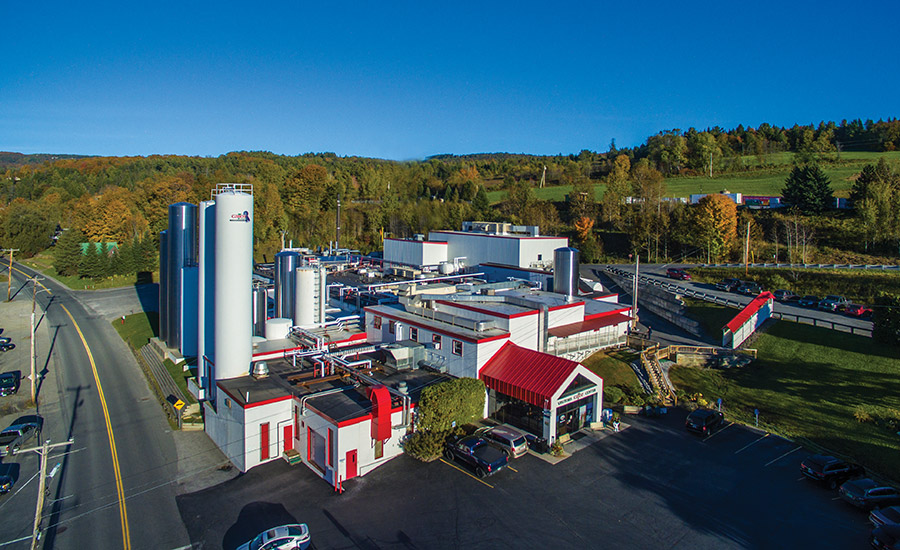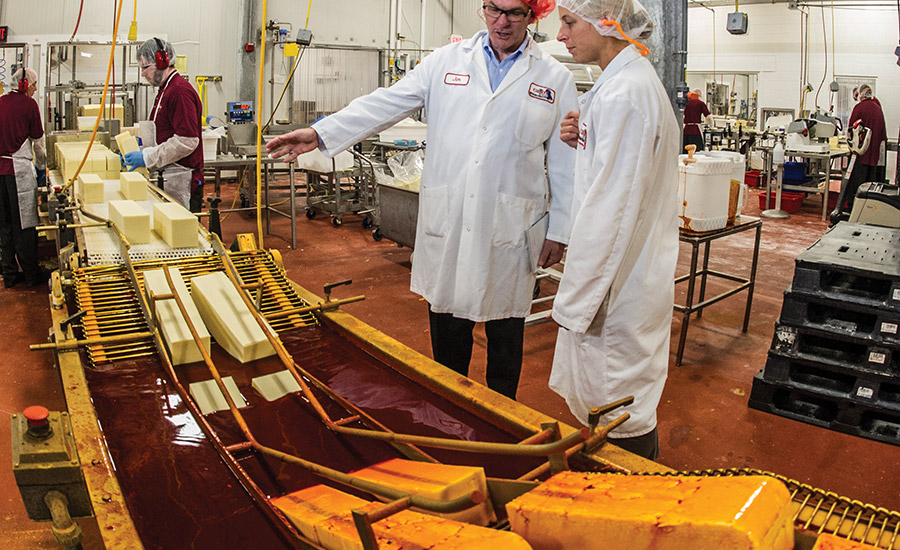Cabot Creamery is looking sharp: inside the dairy plant

Cabot Creamery has a visitors’ center attached to its cheese and cultured products plant in Cabot, Vt. Visitors can sample and purchase Cabot products, logoed items and other made-in-Vermont foods. Other centers are in Waterbury, Vt., Quechee, Vt., and Portland, Maine.

In the cut-and-wrap plant, Production Manager Cristin O’Donnell holds a loaf of wax-covered Cheddar cheese. She manages nine packaging lines in this building.

Loaves of cheese exit a bath that gives the naturally aged white Cheddar an orange hue.

The plant in Cabot, Vt., has four 44,000-pound horizontal cheese vats. They were installed in 2001 and replaced open cookers.

Whey and curds are pumped over to tables, the whey is drained off and the curd is salted. A plow pushes the mass to the die and then the curds are sucked into the two towers by vacuum pressure.

Blocks of white Cheddar are bagged. Later, they will be vacuum-sealed and boxed. Boxes of cheeses are cooled, then shipped to a warehouse for aging and grading.

A package of horseradish-flavored cheese zips along a conveyor in the cut-and-wrap plant in Cabot, Vt. The plant has nine lines where cheese is packaged into various formats. It runs two production shifts a day, five days a week.

In the cut-and-wrap plant, an employee places a block of cheese on a conveyor where it will be converted into smaller formats. Employees here stop for scheduled “micro-breaks” to stretch their rotator cuffs, wrists and backs. The breaks have reduced workers’ compensation claims.

Regional Plant Manager Marcel G. Gravel has been making cheese for almost 45 years. “We’ve got extremely good quality milk coming in here,” he said.

Replacing open vats with enclosed vats has improved the yields and the quality of cheese, said Chris Pearl, the manufacturing team assistant plant manager.










Agri-Mark is a dairy cooperative with 1,200 members in the Northeast United States. It markets 3.5 billion pounds of milk annually, supplying fluid milk to HP Hood, Dairy Farmers of America, Dean Foods and other dairy processors. Agri-Mark also operates four processing plants of its own with two in Vermont (Cabot and Middlebury, that make cheese, cultured products and ingredients), one in West Springfield, Mass. (butter, cream and ingredients) and one in Chateaugay, N.Y. (cheese). The co-op owns the Cabot and McCadam brands. (See related article)
Dairy Foods toured the Cabot, Vt., facility, where Agri-Mark processes about 1 million pounds of milk daily. “We’re tiny” compared to other cheesemakers, said Regional Plant Manager Marcel G. Gravel. The plant produces Cheddar and specialty cheeses, yogurt and sour cream.
Plant tour
Milk tankers begin arriving at 4 a.m., and don’t stop until 6 p.m. The receiving area can handle three trucks at a time (unloading two and cleaning one). Tankers hold 3,800 to 5,000 gallons of milk. The smaller ones, known as “pups,” are used on the narrow and hilly roads of rural Vermont, which would be difficult for full-size tankers to navigate.
Gravel noted that before trucks are allowed to hook up to the system, milk samples are drawn and sent to the on-site lab. The seals are checked and cross-checked against paperwork to make sure the seals are the same, he said.
The entire receiving process, from testing samples to unloading, is computerized, said Chris Pearl, the manufacturing team assistant plant manager.
“The seal records are kept in the computer. The lab sees the load come in on the computer. The sample goes to the lab and they check it for antibiotics, and do a direct microscope count on it. And then they call down to the receiving bay and release it to go to the silo,” Pearl said. Other tests include organoleptic and color checks.
“We’ve got extremely good quality milk coming in here,” said Gravel, who has been making cheese for almost 45 years. He noted that the Vermont standard for standard plant count is 300,000 and for the milk it receives, the SPC is less than 10,000.
“You can take good milk and make garbage out of it, but you can’t take bad milk and make good cheese out of it. If it doesn’t meet our standards, we send it out,” he said.
Milk arrives at 38 to 40 degrees and is kept cold throughout the handling. Flow meters measure the quantity of the raw milk coming out of the trailer as it flows into the silos. The Cabot plant has one 30,000-gallon-capacity silo and three 50,000-gallon silos. When it’s time to make cheese, the milk is pumped to the HTST pasteurizer.
The pasteurized milk then flows directly into the vats. The plant has four 44,000-pound horizontal cheese vats. They were installed in 2001 and replaced open cookers.
“We used to have open vats and now we have the enclosed vats. So the yields are not only better, but the quality of cheese is even better,” Pearl said.
New equipment has made the cheesemaker more efficient. Instead of hand milling curd, the equipment does it.
“When you mill curd, you lose about 1% of cheese yield,” Gravel explained. “I don’t care how good a cheesemaker you are. Once you slice that cheese, it leaks a little butterfat out of it and it’s gone. It goes into butter but it’s not in the cheese.”
While automation has increased yield, cheesemaking still requires human intervention. Art and science are required. While equipment is the “science” in cheesemaking, knowing when to cut the curd is the “art.”
“It’s pretty much all automated except for when to cut the cheese to get the biggest bang for your buck,” Gravel said. “A cheese maker still checks it with his finger even though the machines say it’s ready. And we’ve experimented with automatic cutters and stuff. They’re not fool-proof.”
The Cabot plant essentially runs three shifts. Pearl breaks it down as two-and-a-half production shifts and half a shift for cleaning and sanitizing.
“Everything’s staggered,” Gravel said. “Cheese cook is the first person who comes in because it takes around three hours to get everything rolling. And the next crew comes in and then it takes another 45 minutes from there to start filling the towers. The next person comes in and so forth.”
Meanwhile, equipment is cleaned and sanitized as processes are completed.
The whey and the curd are pumped over to tables. The whey is drained off and the curd is salted. A plow pushes the mass to the die and then the curds are sucked into the two towers by vacuum pressure. Gravity and pressure knit the curds together. The cheese descends the tower and is cut into 40-pound blocks, vacuum-sealed in plastic bags and conveyed to a boxer. The cardboard box is weighed and labeled, and then sent to a storage building to cool. After that, the cheeses are shipped off to various warehouses for aging and grading. Cabot has more than 130 million pounds of cheese in storage.
The first evaluation is after three months. At that point, the graders determine if the cheese will be mild, sharp, extra sharp, private stock or vintage. Two of the longest tenured graders are Earl Elliot and Ted Evans, each of whom has more than 40 years of experience.
CEO Ed Townley said Cabot’s Cheddar cheese has a “northeast flavor profile,” meaning that it is sharper than that of other brands. “Much of the country actually prefers a milder cheese,” he said. Nevertheless, Cabot consistently wins awards in professional and consumer contests.
Gravel noted the similarities between raw milk and the grading process. Just as “bad milk makes bad cheese,” if the cheese is not handled properly in the first 72 hours, “the cheese can go bad as well,” he said “because it takes 72 hours for everything to stabilize in a piece of cheese.”
He explained why. The cheese going into the towers is under vacuum so it is constantly drawing to the outside. Once the guillotine cuts off a block and the cheese is pushed into a bag, “everything that’s been drawn to the outside is migrating back to the center portion again. It takes 72 hours for the moisture in that block, the salt in there, and the PH to stabilize out. If you cool that too rapidly, what happens is that it doesn’t totally get migrated back to where it needs to be.”
Cut and wrap and aging
Up the hill from Agri-Mark’s cheese plant is the cut-and-wrap facility where cheese from all of Cabot’s plants are packaged. Production Manager Cristin O’Donnell showed Dairy Foods the nine packaging lines in this building. Employees break down 40- to 700-pound blocks of cheese and put them onto conveyors where they are converted into various formats, from 6-ounce bars to 10-pound loaves. Certain one- and two-pound blocks are dipped into wax baths; first clear wax, then black wax. These are popular items given as holiday gifts.
O’Donnell greeted employees as she walked through the plant, consulting with them on problem solving, or just saying “hello.” She said she observes employees’ body language. From this she can determine if employees are relaxed, stressed or perhaps focused on something other than the task at hand. During our visit, music sounded and the employees took a break. These time-outs to stretch have helped reduce worker compensation claims, Gravel said.
Cheesemaking used to be a labor-intensive process. Gravel recalls that 30 years ago there were 43 people per shift. Now, a shift requires only six or seven individuals, depending on what is being made. And Cabot is making more cheese per shift than it was in 1985.
“We were only making 8 to 10 vats of cheese a day. And they were smaller vats,” Gravel said.
Now the plant turns out 38 to 40 million pounds of cheese a year. Automation also solved other problem: finding labor.
“For one thing, we couldn’t find the people today to do the work that we did back then,” Gravel said. “That was why we did so much experimenting with stirred curd. I will give you just a little history on that. We’d take one silo of milk, 50,000 gallons of milk. We’d split it up. We do half the day cheddared by hand, and the other half was stirred curd. We did that for about nine months.”
At that point, the cheese was ready for a blind taste test.
“Not one person picked the milled curd as being better,” Gravel recalled. “Every single person [picked] the stirred curd as being better cheese than the cheddared was. We never cheddared another piece of curd by hand after that (except when there was a power outage).”
Cultured products are manufactured in a separate room. There the milk is run through an HTST pasteurizer and then cultured and incubated. The plant produces about 39 million pounds of cultured product annually, and there is room to grow, Townley said.
Because the plant makes reduced-fat cheeses, it has excess cream. That is used to make sour cream. That product line is so successful that the Cabot plant sometimes needs to order cream from the butter plant in West Springfield, Mass.
Employee training and safety
Besides food safety, Agri-Mark looks after employee safety. Every two hours, music comes on over the intercom and employees stop for “micro-breaks” to stretch their rotator cuffs, wrists and backs. This is particularly helpful in the cut-and-wrap plant where the jobs involve so much repetitive motion. Agri-Mark hired a physical therapist who determined the best stretches to do, Gravel said. Office workers also benefitted because the therapist recommended chairs and desks with better ergonomics. These measures were so beneficial that the co-op was able to reduce the costs of its workers compensation insurance.
The co-op also hired a full-time safety coordinator who visits all four plants. She monitors behaviors, like making sure that people are lifting correctly. And she holds safety training, with annual refresher courses. The long-term benefit is that she helped to instill a culture of safety.
Sustainability
The co-op’s sustainability pledge reads: “Living within our means and ensuring the means to live.” Cabot formalized this into a program known as Real Farm Power and the message is shared with customers on packages of Cabot butter. One-half million packages bear the message “Cows in our cooperative provide cream AND electricity for the butter we churn.”
Real Farm Power addresses food waste, nutrient management, resource recovery, renewable energy, greenhouse gas emissions, customer collaboration and consumer education. For example, food waste and cow manure are digested to create gas that power generators to create electricity.
Just as Agri-Mark is careful about getting the greatest yield from a pound of milk, it also takes that same attitude toward the natural resources it uses to manufacture cheese. For example, it recovers water from whey and uses it in the CIP system to clean everything in the plant. The state of Vermont allows the plant in Cabot to draw 110,000 gallons of water a day, and it used to draw 90,000 gallons. Because of the measures mentioned above, the plant draws just 30,000 gallons.
By volume, the plastic bands that encircle pallets are one of the largest items recycled. The plant chips the clean plastic and stores it in 30-gallon drums. When the plant has filled a trailer-load of drums, a recycling service hauls them away. Food scraps are recycled into animal food for local farmers.
Efficiency Vermont is a state program that offers incentives for lighting and energy efficiency. All of Agri-Marks plants in Vermont participate. Plant managers have replaced motors with high-efficiency models, installed roof-top solar panels that run the dumpsters and converted oil boilers to burn compressed natural gas. That allows the plant to get more heat out of the boilers.
Townley noted the three biggest costs in running a cheese plant: milk (about 82%), labor and benefits (8%) and energy (5%). Moving from oil to natural gas has reduced Cabot’s carbon footprint by 40%, he said.
The co-op, through its sustainability efforts, has tied together farmers, plant employees and consumers. Farmers digest manure to create methane gas, which is cleaned up and used to power generators which churn butter (made in West Springfield). Through the messaging on the butter packages, consumers learn about the co-op’s green manufacturing efforts. It’s a farm-to-fork approach. These efforts have helped Cabot achieve B Corporation certification. (B Corps are judged on their social and environmental performance, accountability and transparency, as certified by the nonprofit B Lab.)
Agri-Mark is investing in new equipment and processes throughout its system. The plant in Chauteaugay, N.Y., will be a showcase when completed later this decade. A renovation and expansion will result in eight new cheese vats and a doubling of production capacity.
Automated equipment takes some of the “art” out of making cheese. But even a veteran cheesemaker like Marcel Gravel sees the benefits.
“I’ve adapted to some of the new ways, but I’ve got some of the old school in me as well,” Gravel said. “I do believe in the new technology because it’s far better. We’ve found over time that we can make a lot better piece of cheese from stirred curd than we can from hand cheddaring. I go with ‘the proof is in the pudding.’ We sell a lot of cheese.”
Photos by Vito Palmisano
Looking for a reprint of this article?
From high-res PDFs to custom plaques, order your copy today!
















